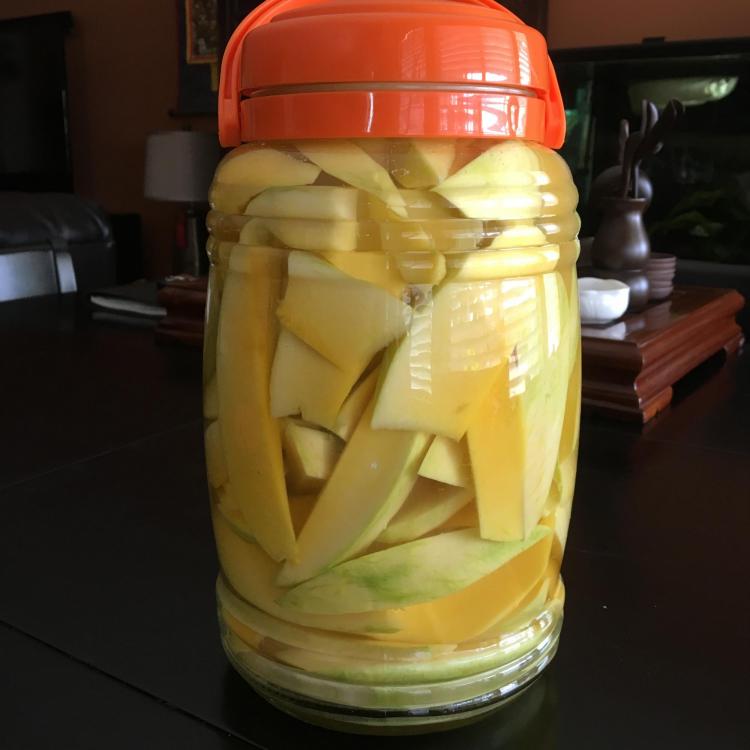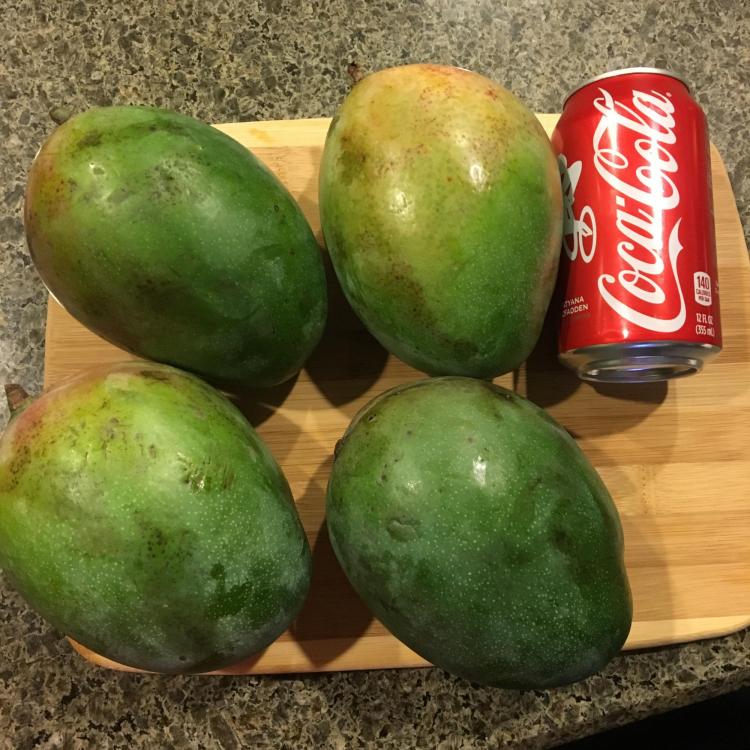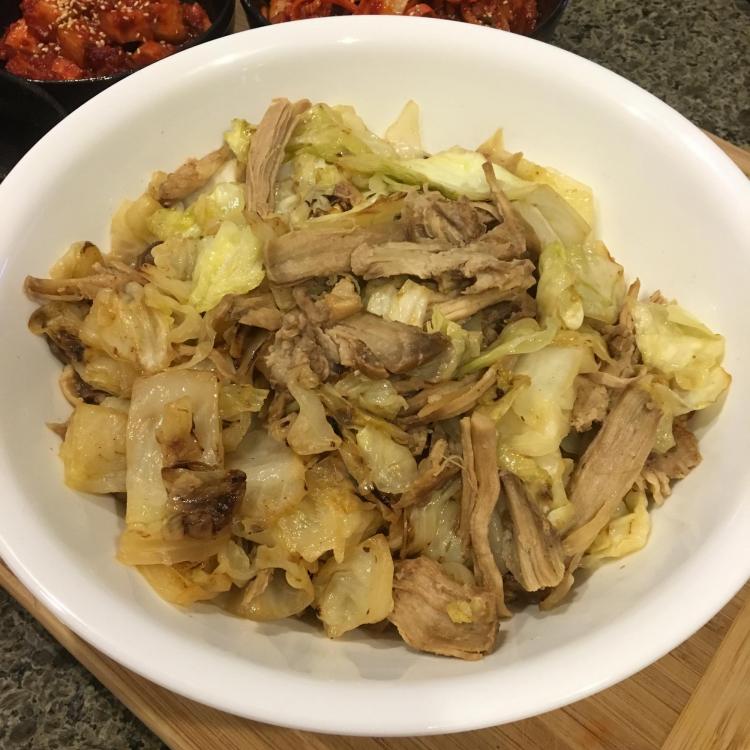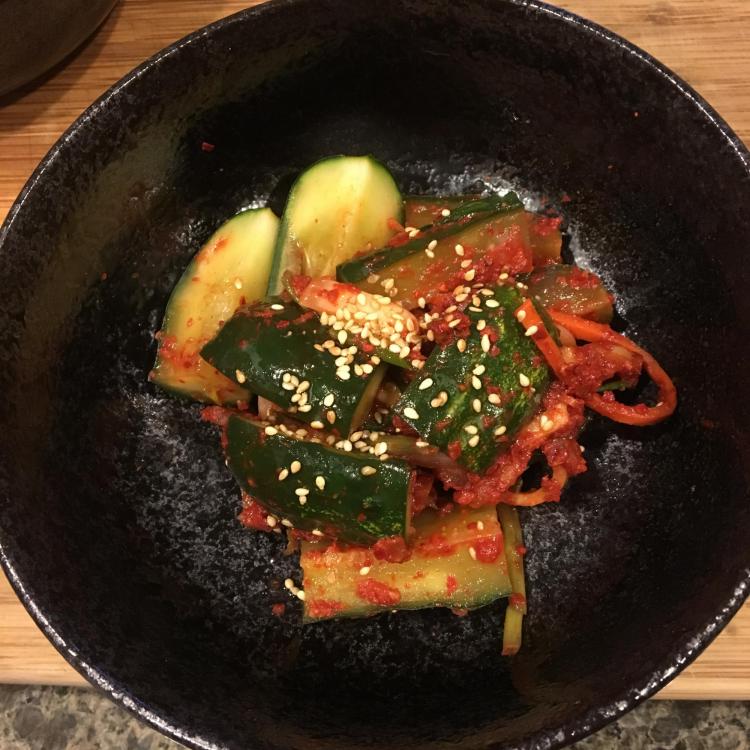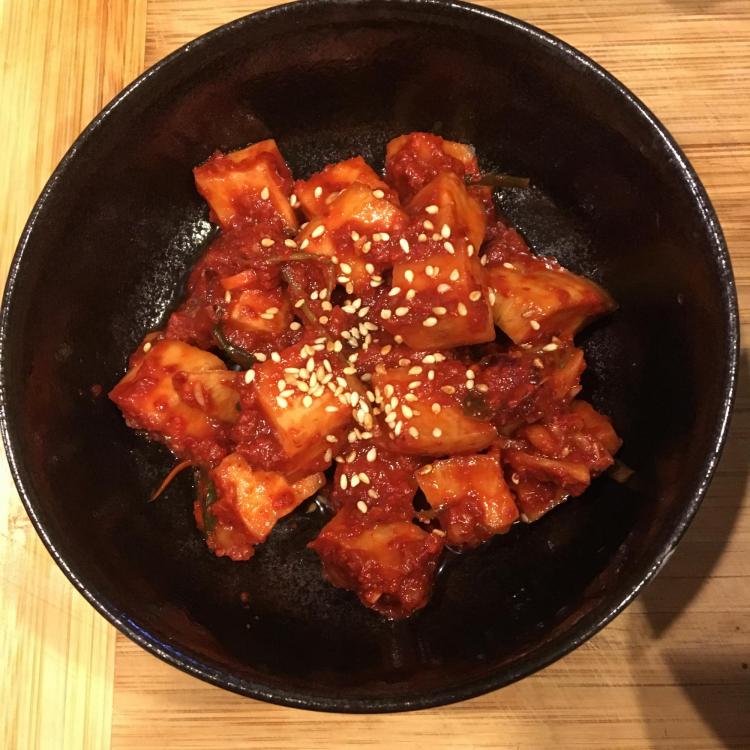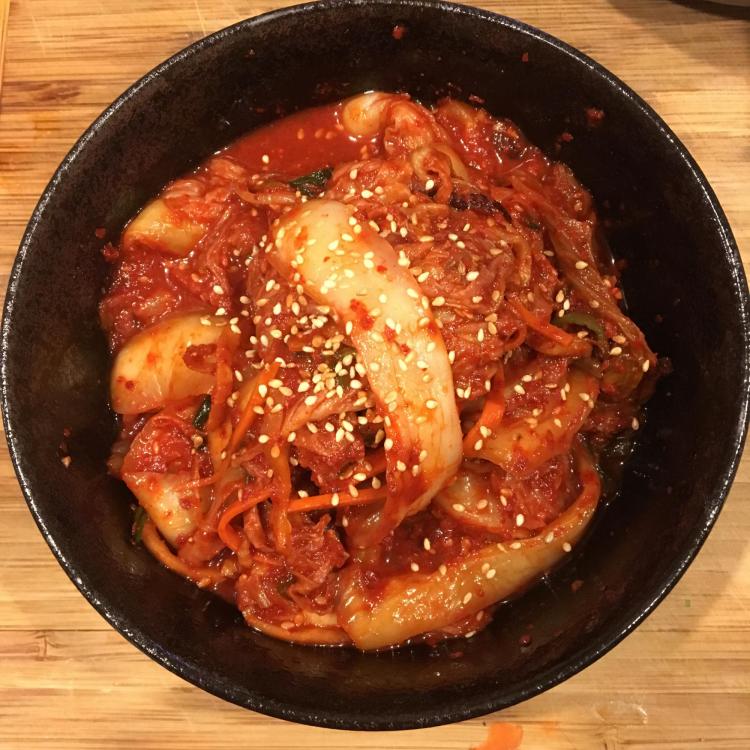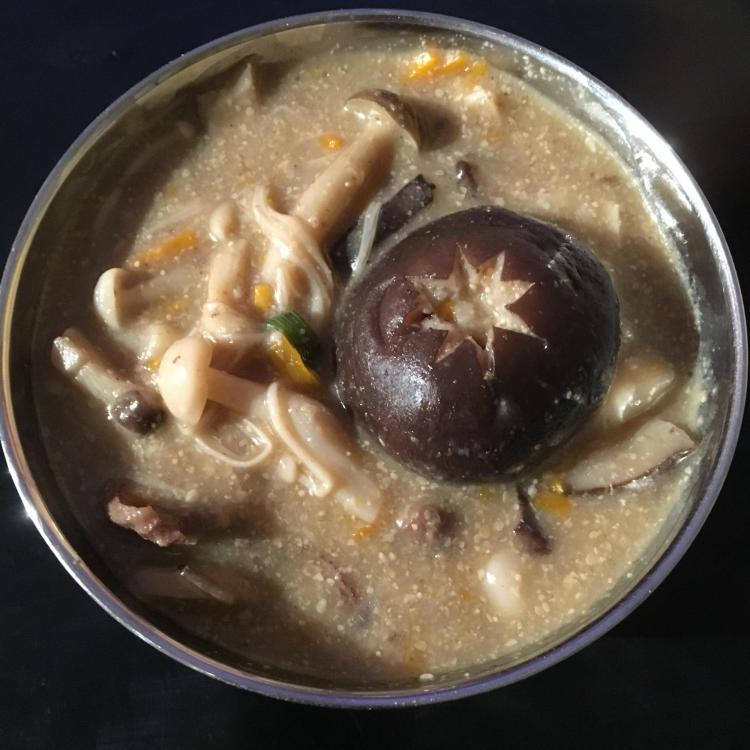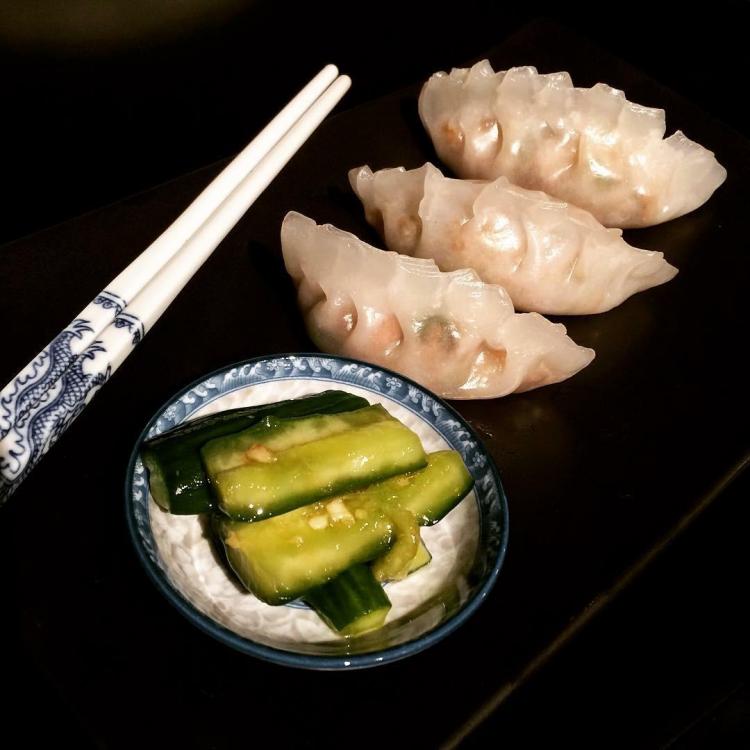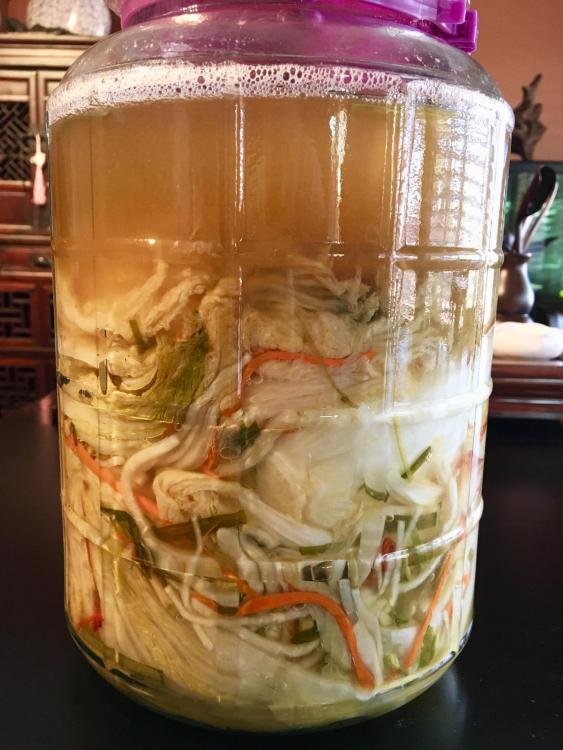-
Posts
66 -
Joined
-
Last visited
Content Type
Profiles
Forums
Store
Help Articles
Everything posted by Wild_Yeast
-
I have other ongoing preservation/fermentation projects right now as well. Several types of kimchi, Korean soybean paste/Doenjjang, pure soybean soy sauce, and Japanese rice bran pickles/nukazuke. Had I seen this thread sooner...
-
During the initial brining I don't believe there's actual fermentation happening yet. But by doing so in brine, absorption of salt via osmosis makes the salting process even all through out the mango vs surface salting, the exterior ends up being way saltier than the interior, Unlike daikon, cabbage or cukes, unripe mango cell walls are too rigid to accept the coarse salt as it is, you'll need a "vehicle", in this case water, to introduce it to all available surface area. During the sugar solution part is when the fermentation actually starts. As far as how active it can be, depends on your ambient temperature. My house temp is 72 year round, cooler than what most people prefer ( I have planted aquariums, and most of the plants I have tend to melt in warm environments ) & sometimes fermentation takes longer than what is normally suggested so I go 2-3 days longer. My parents keep theirs at 76-78, most things ferment "on time" at their place. You'll start seeing tiny bubbles appear within 24 hours. I suggest leaving some headspace of an inch and a half to two to prevent it from bubbling over. Within day three when you burp it, you'll definitely start to smell signs of active fermentation. At day 7, it will smell like fruit wine, but still not alcoholic enough to make one intoxicated. It's time to slow/halt the fermentation and stick it in the fridge, test one, it should be crunchy like a pickle should be, if it turned mushy either almost ripe mangoes were used, or it wasn't salted properly in the beginning(fail).
-
@Wayne hi there, it is different from the Indian style pickled mangoes. It's simpler than the Indian style, no spices or oil. I'm not sure exactly where the origins of the recipe we use came from, I'm almost certain my mother got it from one of her labs at the university when she was studying to be a Nutritionist back in the 70's. It's a 2 part process like I mentioned in the earlier post, select the greenest mangoes available, if you're close to a mango orchard and have that luxury, the mangoes that had just gotten to its maximum size a week or two before the ripening stage occurs are the best. Mangoes are washed, peeled and sliced in wedges then packed tightly in a sterilized jar. The brine ratio is 3 heaping Tbsp of salt to every 8 fl oz of purified water. Dissolve the salt well then pour gently over the mangoes so as not to create more air pockets. Shake and tap the jar to get rid of bubbles. Place a sterilized saucer or pickle weight on top and cover for 24 hours in a cool dark place. A few hours before the 24 hrs is up, make the sugar solution, 5 Tbsp of sugar to 8 fl oz purified water, bring to a boil then cool completely. Then at 24 hrs drain the brine, give the mangoes and the jar a really quick rinse with purified water. Then drain thoroughly, pack the mangoes back in the jar. Pour the sugar solution, get rid of air pockets. Place pickle weight, cover and let it ferment for 7 days in a cool and dark place once more. I burp the bottle every other day just to make sure my bottle doesn't explode from gas buildup. The taste is sweet, sour and salty with the slight aroma of young fruit wine and the texture should be crunchy. You can place them in the fridge at this point to slow down fermentation. I brined these last night as soon as I got home. Every moment that passes the mangoes goes closer to ripening specially in the dessert heat.
-
I found some very green mangoes at the Asian Market today, I got 4 large ones to make pickled mangoes, just looking at them is making me pucker. Gonna soak the peeled and sliced flesh in brine for 24 hrs. drain then pickle in a sugar solution for a week. I placed a pop can next to it just to show how humongous these things are.
-
Korean mushroom soup, shitake, oyster, white and brown shimeji and enoki mushrooms and beef soup Kahlua pork and cabbage and three types of homemade kimchi, Napa cabbage, cubed radish and cucumber respectively
- 488 replies
-
- 18
-

-
We don't have to use ALL the ingredients right? @sartoric I would use the shin beef and spinach to make Khoresht e Esfenaj/Persian spinach stew with beef, turmeric powder, potatoes and lemon juice. The shin would be amazing when it's simmered long and low, the tendons in the stew would just melt into the sauce making it rich without adding thickeners or butter to emulsify the resulting gravy. Serve with plain buttered rice or flatbreads. Day 2 the chicken cutlets, zucchini, eggplant cauliflower and tomatoes can be made into Thai curry if you have Thai basil in your garden OR into Indian Korma if you don't have Thai basil. Serve with plain rice or flatbreads then for day 3, mussels in white wine. But I'd crisp up some bacon, use the bacon grease to sweat the shallots and leeks. And finish the sauce with butter and parsley and top with crumbled bacon. Crusty bread a must lol
-
Alright here you go, -frozen chicken tenderloins -enoki mushrooms -red leaf lettuce -kahlua pork leftovers -cabbage -carrot -Fuji apples -Mexican squash -kimchi ( old and fresh ) -Corinth grapes Spice selection is extensive from Mexican, Indian, Chinese, Thai, Persian and Arabic. Herb garden has Genovese Basil, Thai basil, Thyme, Marjoram, Oregano, Lemongrass, Lavender, Mint, Lemon Verbena, Ginger (they should be somewhat ready for harvest), Sage, Thai bird eye chili and cayenne peppers still available. Several types of soy sauce, fish sauce, Korean bean paste and several selections of vinegar and raw honey. *I'm going to throw a curveball here . The last few months I've been eating pretty clean, no refined sugar, no soda, no wheat products ( trying to see if I'm sensitive to gluten ) and no rice. So far I've lost 30 lbs. but I'm still over my weight limit. I think I'll continue with this type of lifestyle for a while longer till I reach my goal. With that said I can't wait to see what you guys can create with my ingredients. Let the hunger games begin... And may the odds be ever in your favor!!!
-
Not food related... But isn't Burgos a part of the famous Camino de Santiago path?
-

A Day in the Life of a Las Vegas casino cook's helper
Wild_Yeast replied to a topic in Restaurant Life
I was waiting for the cable guy to show up...and this thread surely kept me busy. I wonder how @ScoopKW is doing nowadays. -
Aww man I just posted my list on the other thread... Should we just combine the two threads?
-
Alright here you go, -frozen chicken tenderloins -enoki mushrooms -red leaf lettuce -kahlua pork leftovers -cabbage -carrot -Fuji apples -Mexican squash -kimchi ( old and fresh ) -Corinth grapes Spice selection is extensive from Mexican, Indian, Chinese, Thai, Persian and Arabic. Herb garden has Genovese Basil, Thai basil, Thyme, Marjoram, Oregano, Lemongrass, Lavender, Mint, Lemon Verbena, Ginger (they should be somewhat ready for harvest), Sage, Thai bird eye chili and cayenne peppers still available. Several types of soy sauce, fish sauce, Korean bean paste and several selections of vinegar and raw honey. *I'm going to throw a curveball here . The last few months I've been eating pretty clean, no refined sugar, no soda, no wheat products ( trying to see if I'm sensitive to gluten ) and no rice. So far I've lost 30 lbs. but I'm still over my weight limit. I think I'll continue with this type of lifestyle for a white longer till I reach my goal. With that said I can't wait to see what you guys can create with my ingredients. Let the hunger games begin... And may the odds be ever in your favor!!!
-
When I make the silver ear with wolfberries and rock sugar dessert I simmer it for 2-4 hrs in the crockpot, high for the first hour then low for the remainder of the time. The consistency turns gelatinous but still holds some shape. The idea is to mimick birds nest with the snow fungus since the former is so expensive and the latter is significantly cheap, yet the collagen filling, anti-aging and skin plumping properties are said to be the same.... And why harm the swiftlets? when you can get it from mushrooms
-
Oh yay! What I thought was sweet and yummy dried persimmons strung up in the winter turns up to be a sea creature delicacy that sucks up heavy metals and taste like iodine. Lol I would have never been able to guess 1 & 2 even if my life depended on it.
-
Hahahaha these are definitely dry, I don't think I've ever seen the fresh variety here in the US. I've only had the crunchy batch twice. I didn't mind it for savory soups and stir fry, but it doesn't quite work for the dessert.
-
@liuzhou are there two types of the silver ear mushroom? We use it all the time for soups and dessert. Sometimes after simmering for a couple of hours it softens real good like it's supposed to, and thickens the soup properly, but sometimes there's a batch(I don't get the same brand all the time) that even after two hours of simmering, it stays pretty crunchy and since it doesn't "melt" so the soup stays watery.
-
Thanks @Okanagancook , it is that one. The recipe I use has wheat and tapioca starch instead of rice starch. They're not "dreadfully difficult" lol, as a matter of fact I think they're much easier to work with than the wheat flour kind. you can't overknead it since there's no gluten to worry about. It's only biggest enemy is when it gets too cold, the starch seizes and crumbles. So you have to work fast, or get an assembly line of volunteers, family works best. Lol
-
Steamed the last of my homemade Chiuchow dumplings. Ground pork, Asian chives, Chinese celery, shitake mushrooms and roasted peanuts wrapped in crystal wrapper. Also made Beijing-style Smashed Cucumber salad.
- 488 replies
-
- 22
-

-
Quite interestingly we do not use store bought herb blends ourselves. My mom says "who knows how long they've had that prepackaged and what's really in it!" I have my own stash of Chinese herbs for the herbal soups, honestly it's the same herbs that pop up for most of the other herbal soups just different quantities. Your herb blend is pretty much similar, except the quantity of the cloves and star anise, we only put no more than a dozen cloves and 3 star anise. Cinnamon, black cardamom and mandarin peel is the same. The only difference with ours as far as spice blend is we have coriander and cumin. My mother's side is of Hokkien descent that settled in the Philippines. BKT was limited in the Chinatown area and specialty restaurants. So most Filipino Chinese families normally have to make their own. You guys are so lucky in SG or Malaysia, get hungry at 11pm, just go outside and hit a hawker stall on the street. Lol I remember that post where Ah Leung threw away the soup. I was a member back then(I left and just recently came back after 7 yrs), everyone lost it "YOU THREW AWAY THE SOUP!!!" Heh
-
Moroccan chicken tagine with okra, then cut the eggplant, squash and zucchini in half sprinkle salt and cumin, drizzle with olive oil and roast or grill. Cook rice with salt, butter and saffron/turmeric.
-
@huiray Honestly I didn't know there were other types? I just know the one I grew up with, I assume it's Hokkien coz that's what my moms side. Rich, semi dark broth with the deep Chinese herbs flavor, button mushrooms, tender riblets, tofu pok, lots of garlic and pan wilted lettuce leaves. Then eat with rice drizzled with oil where the shallots were fried and topped with more fried shallots. Pretty much looks like your picture. Heh
-
@huiray it's 11:42 pm PST, I saw your post and hunger pangs are kicking my butt. Must make BKT this week.
-
Is #2 taro or banana stalks that have been bundled?
-
I was going to wait to do a step by step, but decided I was gonna split it in a few parts instead. I just made this jar on the pic three days ago so it will be a few weeks til I make a new batch. But I'll share the recipe now for those who want to try them out. White Kimchi 1 large Napa cabbage 4-6lbs 1/2 cup kosher or sea salt 1 small Korean radish 1/2-3/4 lb, peeled 1 small bunch Asian chives 1 small carrot, peeled 3 jujubes, pitted 1 bunch Minari stems, save the fronds for other dishes (optional) 1 large Korean pear, peeled and cored 24 garlic cloves, peeled 1/2 inch fresh ginger, peeled 1 small onion, peeled 2 tbsp sea salt 4 cups water - Remove the ugly outer leaves of the cabbage. Split cabbage in half. Then slit the halved cabbage just at the core, keeping the upper leaves intact. Rinse under cold water and try to get water between the layers drain thoroughly. Do not pat dry. - Transfer your cabbage in a basin large enough to hold both halves. Pry the outer layer of leaves gently, just enough for you to sprinkle salt inside, repeat to all the other layers til you get to the core and repeat to the other half. First lay the cabbage halves cut side up, if you have remaining salt sprinkle it generously on areas that looks lacking. Set aside to wilt for an hour and a half to two hours. - Turn the halves every 30 min, in half an hour you'll have plenty of liquid collecting at the bottom. Every time you turn it, scoop some of the liquid at the bottom and douse the leaves. - While waiting for the cabbage, cut the jujubes, radish and carrots into matchsticks. Cut the chives and Minari stems the same length as the radish and carrots. Place everything in a bowl and toss to distribute evenly. Set aside. - Cut the pear and onion in large chunks, add it to the food processor with the garlic and ginger. Process till it becomes a fine paste. Transfer to a cloth bag. - Dissolve the salt in water. Take the bag with pear/onion paste and submerge in the salted water. Use a spoon to press on the pouch to extract the juices from the paste. When you feel it's extracted enough, remove the pouch and squeeze the liquid out and discard the pulp. The resulting milky liquid will be your brine solution. - Bring the cabbage to the sink and discard liquid. Remember the slit we made to the core? Pull it apart to make the halves into quarters. Rinse under cold water twice, then squeeze gently to get rid of excess water. - Starting from the outermost leaves, stuff each layer with the daikon mixture. Repeat till all layers are dressed. Pack firmly into sterilized jars, take care not to pack them too tightly but don't have too much space gaps in between either. - Pour the pear onion brine in the jar over the cabbage. If you have rocks for pickle weights, set it on top of the cabbage now. Clean the mouth of the jar and screw lid loosely. Let it sit on the counter for 3 days. - After the initial fermentation, place in the fridge for another 7 days. Then it's ready to eat after that. *if you don't have pickle weights, it's perfectly fine. Just use a clean ladle and push down gently on the cabbage to expel CO2 pockets from between the leaves during the first three days. And at least once a week when it's already in the fridge.
-
@Smithy gave me a hint, on number 1, they're persimmon that are strung and dried. Yes? Still scratchin my head on 2 and 3
-
I was going to wait until I made another batch but what the heck. So most of you are familiar with traditional kimchi, it's cabbage fermented with a myriad of vegetables and loads of the unmistakable red Korean pepper flakes. It's spicy, tangy, fizzy and rich with umami enough to whet the appetite. But not everyone is into spicy food, and others have dietary restriction regarding the seafood in the paste blend. So I introduce the not so popular sister white kimchi. This is more akin to the European Sauerkraut, but of course the flavor profile is much more complex than just caraway seeds. A little history, before the introduction of chili peppers in Asia, kimchi was originally made this way. Come the16th century, trade routes from the Americas finally reached most of Asia and introduced the chili pepper, though Koreans and Chinese will dispute that according the the Imperial Material Medica of those times, chili peppers were already being used as medicine since 850 and Koreans by the early 1400's, but there were no proof of cultivation. These peppers produced immediate heat sensation upon ingestion and through the theory of oriental medicine was believed to have Yang properties. Kimchi which was already known to have cooling effect or Yin properties because of its sour taste and the type of vegetable used in it is primarily eaten during the cold winter months, people started adding chilies into their kimchi crocks to balance the properties of the food and give them internal warmth in the winter. Eastern cultures believe that food can also be medicine. One legend of how kimchi with chili pepper came about was, there was a king who had weak constitution, and usually of no appetite, and guess what, the only thing he'd peck on is the kimchi side dish. The imperial kitchen who monitors what the royal family eats are at wits end on what to do. A clever court attendant who was assigned in the imperial kitchen secretly added chili peppers in the crock knowing its medicinal properties. The king ate the new kimchi, took another bite, then another, the spiciness whetting his appetite, then a few more days later the king was eating his full meal. The queen, delighted, asked her own court attendants to find out who's been preparing the king's meal. When she found out it was, the queen summoned her and promoted her rank and was designated the sole person to handle the king's meal. The news of the healing properties of the new found kimchi spread across the lands and from then on that's how people started preparing their kimchi and the plain white kimchi was left in the shadows.


